计算机专业英语教案
- 格式:ppt
- 大小:731.50 KB
- 文档页数:31
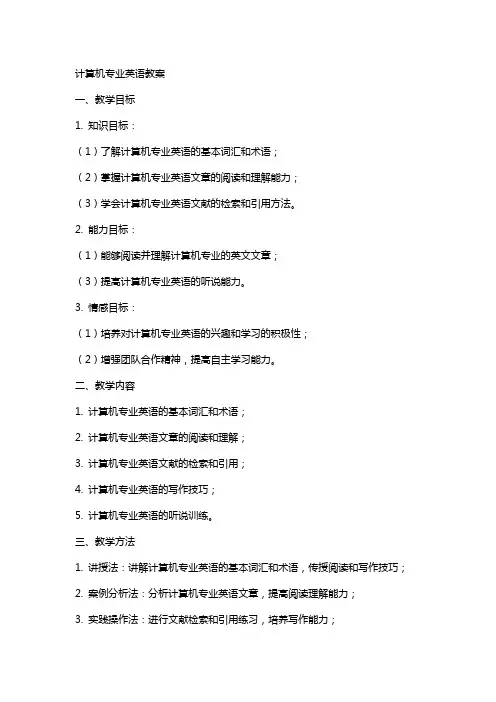
计算机专业英语教案一、教学目标1. 知识目标:(1)了解计算机专业英语的基本词汇和术语;(2)掌握计算机专业英语文章的阅读和理解能力;(3)学会计算机专业英语文献的检索和引用方法。
2. 能力目标:(1)能够阅读并理解计算机专业的英文文章;(3)提高计算机专业英语的听说能力。
3. 情感目标:(1)培养对计算机专业英语的兴趣和学习的积极性;(2)增强团队合作精神,提高自主学习能力。
二、教学内容1. 计算机专业英语的基本词汇和术语;2. 计算机专业英语文章的阅读和理解;3. 计算机专业英语文献的检索和引用;4. 计算机专业英语的写作技巧;5. 计算机专业英语的听说训练。
三、教学方法1. 讲授法:讲解计算机专业英语的基本词汇和术语,传授阅读和写作技巧;2. 案例分析法:分析计算机专业英语文章,提高阅读理解能力;3. 实践操作法:进行文献检索和引用练习,培养写作能力;4. 小组讨论法:分组讨论,提高团队合作精神和自主学习能力;5. 听说训练法:开展听说活动,提高听说能力。
四、教学安排1. 课时:每个章节安排2课时,共10课时;2. 教学方式:课堂讲授和实践操作相结合;3. 教学环节:讲解、案例分析、练习、小组讨论、听说训练。
五、教学评价1. 平时成绩:课堂参与度、练习完成情况、小组讨论表现(30%);2. 期中考试:计算机专业英语词汇和术语、阅读理解、写作(40%);3. 期末考试:计算机专业英语听说能力测试(30%)。
六、教学资源1. 教材:《计算机专业英语》(英文版);2. 辅助材料:计算机专业英语词汇卡片、阅读材料、听力材料、PPT课件;3. 网络资源:相关计算机专业英语网站、数据库、学术期刊等;4. 教学工具:投影仪、计算机、音响设备等。
七、教学步骤1. 引入新课:通过介绍计算机专业英语的重要性,激发学生的学习兴趣;2. 讲解知识点:讲解本节课的主要词汇和术语,引导学生理解并掌握;3. 案例分析:分析计算机专业英语文章,提高学生的阅读理解能力;4. 实践操作:进行文献检索和引用练习,培养学生的写作能力;5. 小组讨论:分组讨论,提高学生的团队合作精神和自主学习能力;6. 听说训练:开展听说活动,提高学生的听说能力;7. 总结讲解:对本节课的内容进行总结,强调重点和难点;8. 布置作业:布置相关练习,巩固所学知识。
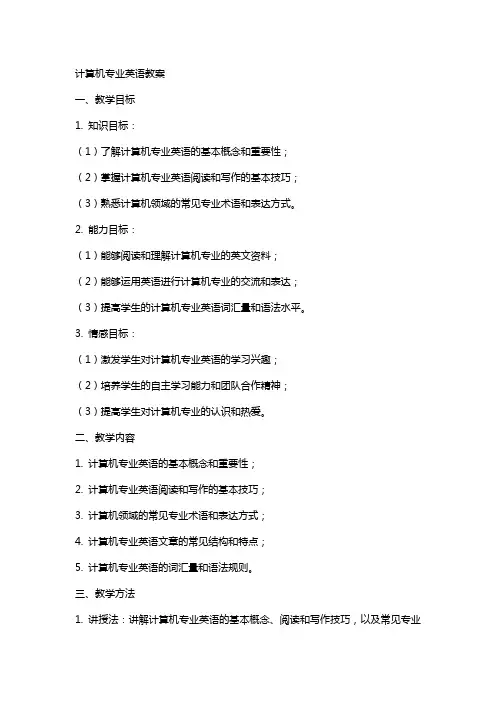
计算机专业英语教案一、教学目标1. 知识目标:(1)了解计算机专业英语的基本概念和重要性;(2)掌握计算机专业英语阅读和写作的基本技巧;(3)熟悉计算机领域的常见专业术语和表达方式。
2. 能力目标:(1)能够阅读和理解计算机专业的英文资料;(2)能够运用英语进行计算机专业的交流和表达;(3)提高学生的计算机专业英语词汇量和语法水平。
3. 情感目标:(1)激发学生对计算机专业英语的学习兴趣;(2)培养学生的自主学习能力和团队合作精神;(3)提高学生对计算机专业的认识和热爱。
二、教学内容1. 计算机专业英语的基本概念和重要性;2. 计算机专业英语阅读和写作的基本技巧;3. 计算机领域的常见专业术语和表达方式;4. 计算机专业英语文章的常见结构和特点;5. 计算机专业英语的词汇量和语法规则。
三、教学方法1. 讲授法:讲解计算机专业英语的基本概念、阅读和写作技巧,以及常见专业术语和表达方式;2. 案例分析法:分析计算机专业英语文章的例子,让学生了解文章的常见结构和特点;3. 实践操作法:让学生进行计算机专业英语阅读和写作的实践,提高学生的实际应用能力;4. 小组讨论法:分组讨论计算机专业英语学习中的问题,培养学生的团队合作精神。
四、教学步骤1. 导入:介绍计算机专业英语的基本概念和重要性,激发学生的学习兴趣;2. 讲解:讲解计算机专业英语阅读和写作技巧,以及常见专业术语和表达方式;3. 案例分析:分析计算机专业英语文章的例子,让学生了解文章的常见结构和特点;4. 实践操作:让学生进行计算机专业英语阅读和写作的实践,提高学生的实际应用能力;5. 小组讨论:分组讨论计算机专业英语学习中的问题,培养学生的团队合作精神。
五、教学评价1. 平时成绩:评估学生在课堂上的参与程度、发言情况和作业完成情况;2. 阅读理解测试:测试学生对计算机专业英语文章的理解能力;3. 写作能力评估:评估学生的计算机专业英语写作能力和语法水平;4. 小组讨论评价:评估学生在团队合作中的表现和问题解决能力。
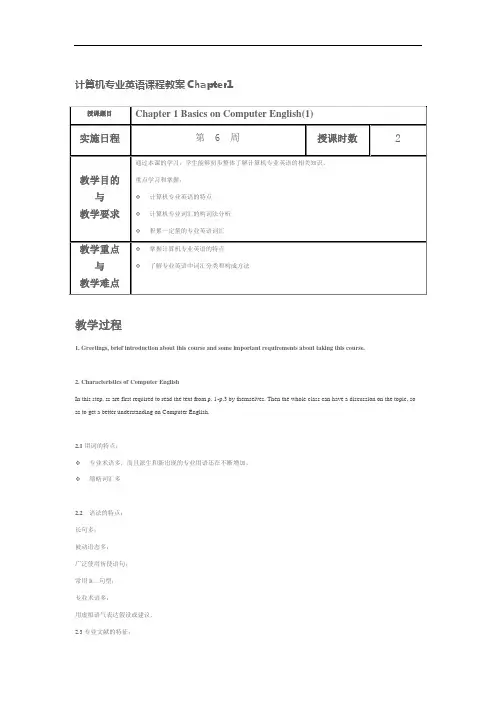
计算机专业英语课程教案Chapter1教学过程1. Greetings, brief introduction about this course and some important requirements about taking this course.2. Characteristics of Computer EnglishIn this step, ss are first required to read the text from p. 1-p.3 by themselves. Then the whole class can have a discussion on the topic, so as to get a better understanding on Computer English.2.1用词的特点:❖专业术语多,而且派生和新出现的专业用语还在不断增加。
❖缩略词汇多2.2语法的特点:长句多;被动语态多;广泛使用祈使语句;常用It…句型;专业术语多;用虚拟语气表达假设或建议.2.3专业文献的特征:❖客观(objectivity)❖精练(conciseness)❖准确(accuracy)3. Word-formation Analyze on CE Vocabularies:3.1专业英语词汇的构成特点❖技术词汇(technical words)例如:bandwidth(带宽),flip-flop(触发器),superconductivity(超导性),hexadecimal(十六进制),amplifier(放大器)等。
❖次技术词汇(sub-technical words)例如:register在计算机系统中表示寄存器,在电学中表示计数器、记录器,在乐器中表示音区,而在日常生活中则表示登记簿、名册、挂号信等。
❖特用词(big words)例如:日常英语中常用下列句子:Then the light is turned on. 在专业英语中,却表示为:The circuit is then completed. 这是由于complete词义单一准确,可以避免歧义。


计算机专业英语课程设计一、课程概述计算机专业英语课程是计算机专业必修的一门英语课程。
此课程旨在帮助学生掌握计算机专业英语基础知识,拓展计算机领域的英语词汇量。
通过本课程的学习,学生将能够读写英文计算机文献,理解计算机术语和相关知识,以及进行国际交流。
二、课程目标本课程的目标主要包括以下几个方面:1.掌握计算机专业英语的基本术语和语言表达能力;2.培养计算机专业英语的听、说、读、写能力;3.学习计算机专业领域的英文文献和技术写作规范,提高文献翻译和创作能力;4.提升学生的跨文化交际能力和国际化视野。
三、教学内容计算机专业英语课程主要包括以下3个部分:3.1. 词汇本部分将重点介绍计算机专业英语中常见的词汇和术语,涉及计算机软硬件、网络等方面。
学生需要通过词汇训练掌握这些术语,并能够拓展英语词汇量。
3.2. 文献阅读和写作本部分将引导学生学习阅读并理解英文计算机专业文献,如学术论文、技术报告、手册等。
通过学习文献,学生将了解计算机领域的最新研究和应用发展动态,并能够运用所学知识写出规范的英文技术文献。
3.3. 口语练习本部分将引导学生练习计算机专业英语口语,包括日常交流和技术演讲,通过模拟实际情境对口语进行培养和训练,提高学生的口语表达能力。
四、教学方法本课程将采用多种教学方法,包括教师授课、学生讨论、课堂演示、课外作业等。
通过丰富多样的教学方法,提升学生的学习兴趣和主动学习意识。
五、学习评估学生的学习将通过课堂表现、课后作业、文献翻译和技术写作等方式进行评估。
此外,还将进行期中考试、期末考试和口语演讲等形式的考核,以评价学生的学习情况。
六、教材本课程的主要教材为《计算机专业英语》系列教材和相关计算机科技期刊,教师还将根据需要适当借鉴其他相关学习资料。
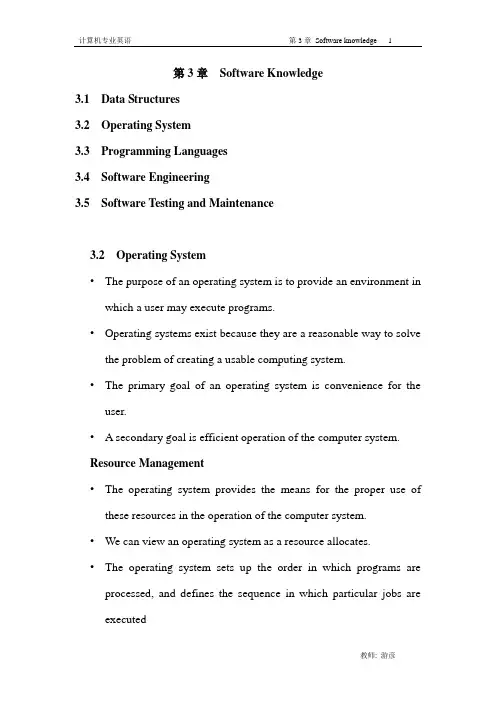
第3章Software Knowledge3.1 Data Structures3.2 Operating System3.3 Programming Languages3.4 Software Engineering3.5 Software Testing and Maintenance3.2 Operating System•The purpose of an operating system is to provide an environment in which a user may execute programs.•Operating systems exist because they are a reasonable way to solve the problem of creating a usable computing system.•The primary goal of an operating system is convenience for the user.• A secondary goal is efficient operation of the computer system.Resource Management•The operating system provides the means for the proper use of these resources in the operation of the computer system.•We can view an operating system as a resource allocates.•The operating system sets up the order in which programs are processed, and defines the sequence in which particular jobs are executed•I/O Management•To facilitate execution of I/O operations, most operating systems have a standard set of control instructions to handle the processing of all input and output instructions.•These standard instructions, referred to as the input/output control system (IOCS), are an integral part of most operating systems. •The controlling software calls on the IOCS software to actually complete the I/O operation.Classification of Operating Systems• A single-user operating system expects to deal with one set of input devices—those that can be controlled by one user at a time.• A multi-user operating system is designed to deal with input, output, and processing requests from many users-all at the same time.• A network operating system provides communications and routing services that allow computers to share data, programs and peripheral devices.• A multitasking operating system provides process and memory management services that allow two or more programs to run simultaneously.•All modern operating systems are multitasking and can run several processes simultaneously.• A desktop operating system is one that is designed for a personal computer—either a desktop or notebook computer.•3.3 Programming Languages• A programming language or computer language is a standardized communication technique for expressing instructions to a computer.• A language enables a programmer to precisely specify what data a computer will act upon, how these data will be stored/transmitted, and what actions to take under various circumstances of cases. •Programming languages are important tools for helping software engineers write better programs faster.Procedural programming and Object-oriented programming •Procedural programming involves using your knowledge of a programming language to create computer memory locations that can hold values and writing a series of steps or operations that manipulate those values.• A single procedural program often contains hundreds of variable and thousands of procedure calls.•Object-oriented programming is an extension of procedural programming in which you take a slightly different approach to writing computer programs.•Writing object-oriented programs involves both creating objects and creating applications that use those objects.Machine Language•An executable program is a sequence of extremely simple instructions known as machine code.•Machine code instructions are binary—that is, sequences of bits (0s and 1s).•Because these numbers are not understood easily by humans, computer instructions usually are not written in machine code. Assembly Language•Assembly language uses commands that are easier for programmers to understand than are machine-language commands. •Each machine language instruction has an equivalent command in assembly language.•Assembly language is sometimes inserted into a high-level language program to carry out specific hardware tasks or to speed up a high-level program.High-Level Languages•If the computer could translate convenient symbols into basic operations, why couldn’t it also perform other clerical coding functions?• A high-level programming language is a means of writing down, informal terms, the steps that must be performed to process a given set of data in a uniquely defined way.•The high-level languages are often oriented toward a particular class of processing problems.Compiler and Interpreter• A complier is a program that translates source code into object code.•Every high-level programming language comes with a compiler. •Because compilers translate source code into object code, which is unique for each type of computer, many compilers are available for the same language.•An interpreter translates high-level instructions into an intermediate form, which it then executes.•The advantage of an interpreter, however, is that it does not need to go through the compilation stage during which machine instructions are generated.•3.4 Software Engineering•Software engineering is the application of tools, methods, and disciplines to produce and maintain an automated solution to a real-world problem.•Software engineering first emerged as a popular term in the title ofa 1968 NA TO conference held in Garmisch, Germany.• A large-scale software projects spans a considerable period of time.A number of distinct phases can be identified over this period oftime. Together, these make up what is known as the “software life cycle”.The software life cycle•Requirements definition: The requirements of the software are established and specified.•Design: A design is developed from an analysis of the requirements.•Implementation: The design is coded in a particular programming language on a particular machine.•Testing: The implemented system is tested to see that it meets the specified requirements.•Operation and maintenance: The system is installed and used.Errors found must be repaired.Requirements definition•The first phase, requirements definition, refers to the period during which the requirements of the system desired, that is, it’s functional characteristics and operational details, are specified.•The input to this phase is the stated (often rather loosely stated) needs for the software.•Typically, a “requirements document” is the output of thi s phase, a set of precisely stated properties or constraints that the final product must satisfy.•As with any of the phases, it is important that errors not be allowed to move into subsequent phases.Design•The second phase, design, is predominantly creative, while some would argue that creativity is inherent and cannot be trained or improved, it can certainly be enhanced by the use of good procedures and tools.•The input to this phase is a (debugged and validated) requirements document: the output is a design expressed in some appropriate form (for example, pseudo-code).•Each requirement in the requirements document must have a corresponding design fragment to meet it.Implementation•The third phase, implementation, is the actual coding of the design developed in the second phase.•The lure of this phase is strong, and many a foolhardy programmer has been drawn to it before adequately laying the groundwork in the first two phases.•As a result, requirements are incompletely understood and thedesign is flawed.•The implementation proceeds blindly, and many problems arise asa result.Testing•The fourth phase, testing, is concerned with demonstrating the correctness of the implemented program. Inevitably some testing is performed as part of the previous two phases as well.•Any experienced programmer mentally tests each line as it is produced and mentally simulates the execution of any module prior to any formal testing stage.• A “successful” test run means only that no errors were uncovered with the particular circumstances tested; it says nothing about other circumstances.•In theory, the only way that testing can show that a program is correct is if all possible cases are tried (known as an exhaustive test), a situation technically impossible for even the simplest programs.Program maintenance•The fifth phase is program maintenance phase. Student programmers, unfortunately, rarely become involved in this phase. •Its importance in the real world, however, cannot be overemphasized, since the cost of maintaining a widely usedprogram can match or exceed the cost of developing it.•Unlike hardware maintenance, software maintenance deals not with repair of deteriorated components, but with repair of design defects, which may include the provision of added functions to meet new needs.。
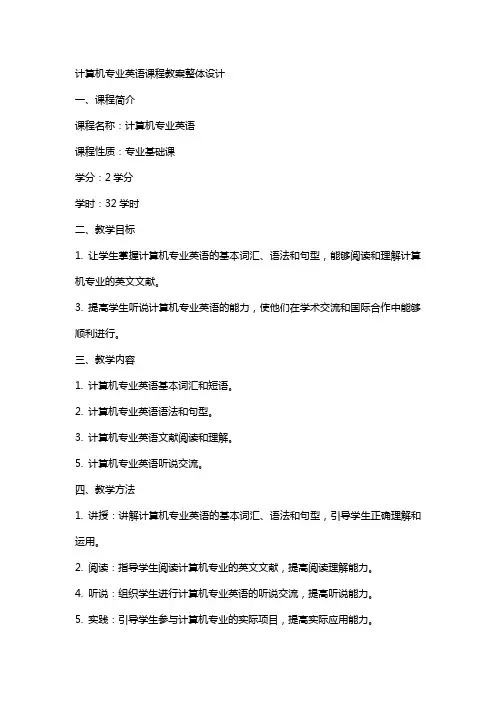
计算机专业英语课程教案整体设计一、课程简介课程名称:计算机专业英语课程性质:专业基础课学分:2学分学时:32学时二、教学目标1. 让学生掌握计算机专业英语的基本词汇、语法和句型,能够阅读和理解计算机专业的英文文献。
3. 提高学生听说计算机专业英语的能力,使他们在学术交流和国际合作中能够顺利进行。
三、教学内容1. 计算机专业英语基本词汇和短语。
2. 计算机专业英语语法和句型。
3. 计算机专业英语文献阅读和理解。
5. 计算机专业英语听说交流。
四、教学方法1. 讲授:讲解计算机专业英语的基本词汇、语法和句型,引导学生正确理解和运用。
2. 阅读:指导学生阅读计算机专业的英文文献,提高阅读理解能力。
4. 听说:组织学生进行计算机专业英语的听说交流,提高听说能力。
5. 实践:引导学生参与计算机专业的实际项目,提高实际应用能力。
五、教学评价1. 平时成绩:包括课堂参与、作业完成情况等,占总评的40%。
2. 阅读理解测试:测试学生对计算机专业英语文献的阅读理解能力,占总评的30%。
3. 英文文档和报告:评估学生的写作能力,占总评的20%。
4. 听说交流测试:测试学生的听说能力,占总评的10%。
六、教学资源1. 教材:选用国内外优秀的计算机专业英语教材,如《计算机专业英语》、《计算机科学英语》等。
2. 辅助材料:提供相关的英文文献、文章、报告、视频等,供学生自主学习。
3. 网络资源:利用校园网和互联网,为学生提供更多的学习资源和交流平台。
4. 教学工具:采用多媒体教学,如PPT、投影仪等,提高教学效果。
七、教学进度安排1. 章节一:计算机专业英语基本词汇和短语(2学时)2. 章节二:计算机专业英语语法和句型(2学时)3. 章节三:计算机专业英语文献阅读和理解(4学时)5. 章节五:计算机专业英语听说交流(4学时)6. 章节六:实践项目(4学时)7. 章节七:阅读理解测试(2学时)8. 章节八:英文文档和报告评估(2学时)9. 章节九:听说交流测试(2学时)八、教学注意事项1. 关注学生的学习兴趣,激发学习积极性。
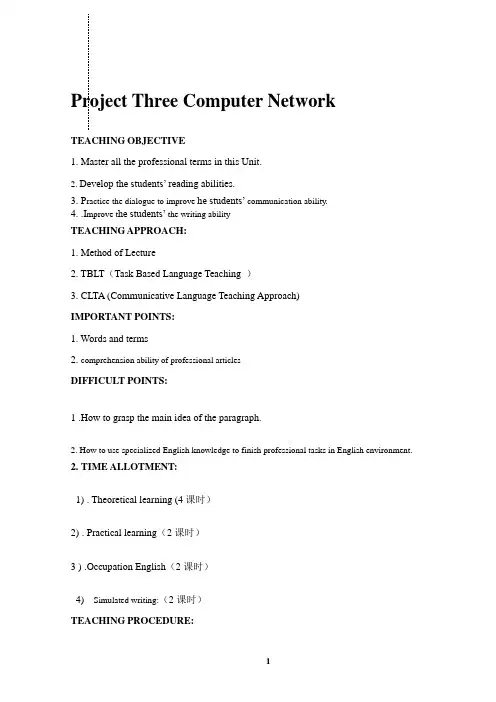
Project Three Computer NetworkTEACHING OBJECTIVE1. Master all the professional terms in this Unit.2. Develop the students’ reading abilities.3. P ractice the dialogue to improve he students’ communication ability.4. .I mprove t he students’ the writing abilityTEACHING APPROACH:1. Method of Lecture2. TBLT(Task Based Language Teaching )3. CLTA (Communicative Language Teaching Approach)IMPORTANT POINTS:1. Words and terms2. comprehension ability of professional articlesDIFFICULT POINTS:1 .How to grasp the main idea of the paragraph.2. How to use specialized English knowledge to finish professional tasks in English environment.2.TIME ALLOTMENT:1) . Theoretical learning (4课时)2) . Practical learning(2课时)3 ) .Occupation English(2课时)4) Simulated writing:(2课时)TEACHING PROCEDURE:I. Part A Theoretical learningIn this part, our target is to improve the speed of reading professional articles and the comprehension ability of the reader. We have marked key words in some paragraphs.Reading:Computer Network1. Background of informationPPT (Omitted )2、Questions before readingWhat is a protocol?According to the geographic range, what are the types of computer network?What are the advantages of LAN?3、NotesICE(Inter-Connect-Equipments),互连设备NOS(Network Operating Systems),网络操作系统TCP (Transfer Control Protocol),传输控制协议IP(Internet Protocol ),互连网协议FTP (File Transfer Protocol ),文件传输协议LAN( local area network),局域网MAN( metropolitan area network) ,城域网WAN( wide area network ),广域网CAN(campus area network),校园网4、Exercises5、.SummaryImportant termsThe main function Of computer NetworkPart B Practical learningIn this parts, students must finish two special tasks in English environment under the guidance of the specialized English teacher. The student must work with each other in the same group.Task 1 Configuring basic FeaturesConnect one of your PCs to one of the four LAN ports on the Router .Configure the router through your web browser with the Web-based Utility. Set the Internet Connection Type to PPPoE. Enable DHCP server, set Starting IP Address to 192.168.1.150, set Maximum Number of DHCP Users to 30. Set Wireless Network Mode to B/G/N-Mixed, set Wireless Channel to Auto, set SSID Name to wr-xingzheng. Set wireless security mode to WEP, WEP keys to 2009121616, and WEP encryption’s level to 64 bits.Task 2 Configuring Advanced FeaturesSelect Gateway in which the Router will function, enable the dynamic routing feature, set RIP Send Packet Version and RIP Recv Packet Version to RIPv2. Enable Wireless Connection Control, and allow only 25 specific client devices to connect to the Wireless Router. Add a new ACL rule to deny the pcs in the lan accessing other hosts out of the lan with FTP protocol. Create an Internet Access policy to allow the pcs in the lan to access the internet during 8:00~17:00, and block access to . Build VPN connection from Local LAN port of one router. Backup the router..Part C Occupation EnglishPaymentTraining Target: In this part, students are supposed to practice the dialogue to be skilled atpayment.Useful Expressions1. We insist on a letter of credit. 我们坚持用信用证方式付款。
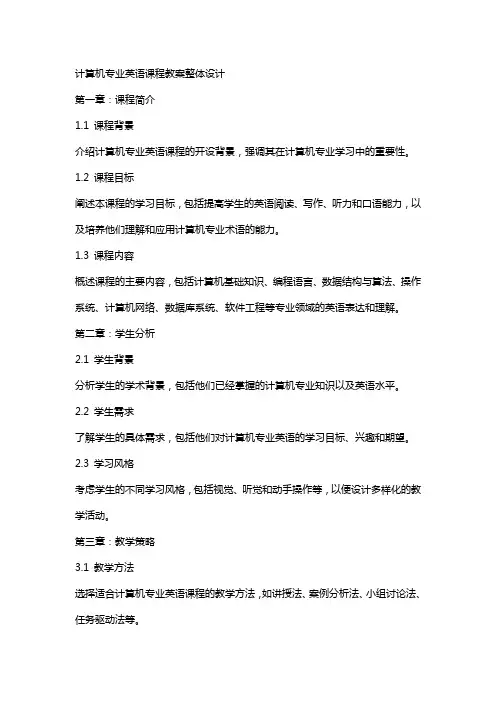
计算机专业英语课程教案整体设计第一章:课程简介1.1 课程背景介绍计算机专业英语课程的开设背景,强调其在计算机专业学习中的重要性。
1.2 课程目标阐述本课程的学习目标,包括提高学生的英语阅读、写作、听力和口语能力,以及培养他们理解和应用计算机专业术语的能力。
1.3 课程内容概述课程的主要内容,包括计算机基础知识、编程语言、数据结构与算法、操作系统、计算机网络、数据库系统、软件工程等专业领域的英语表达和理解。
第二章:学生分析2.1 学生背景分析学生的学术背景,包括他们已经掌握的计算机专业知识以及英语水平。
2.2 学生需求了解学生的具体需求,包括他们对计算机专业英语的学习目标、兴趣和期望。
2.3 学习风格考虑学生的不同学习风格,包括视觉、听觉和动手操作等,以便设计多样化的教学活动。
第三章:教学策略3.1 教学方法选择适合计算机专业英语课程的教学方法,如讲授法、案例分析法、小组讨论法、任务驱动法等。
3.2 教学资源利用多媒体教学资源,如PPT课件、视频教程、在线学习平台等,提供丰富的学习材料。
3.3 教学评价设计合理的评价机制,包括平时成绩、课堂参与度、作业完成情况、期中和期末考试等,以全面评估学生的学习成果。
第四章:教学内容4.1 计算机基础知识教授计算机硬件、软件、操作系统等基本概念的英语表达。
4.2 编程语言介绍常见编程语言的基本语法和关键字,如Python、Java、C++等。
4.3 数据结构与算法讲解计算机科学中常用的数据结构(如数组、链表、栈、队列等)和算法(如排序、查找等)的英语表达和描述。
第五章:教学活动5.1 课堂讲解进行课堂讲解,结合实例和实际应用场景,让学生理解和掌握计算机专业英语词汇和表达方式。
5.2 小组讨论组织学生进行小组讨论,让他们共同探讨和解决问题,提高他们的合作能力和英语口语表达能力。
5.3 案例分析提供实际案例,让学生运用所学的计算机专业英语知识进行分析和解决,培养他们的实际应用能力。
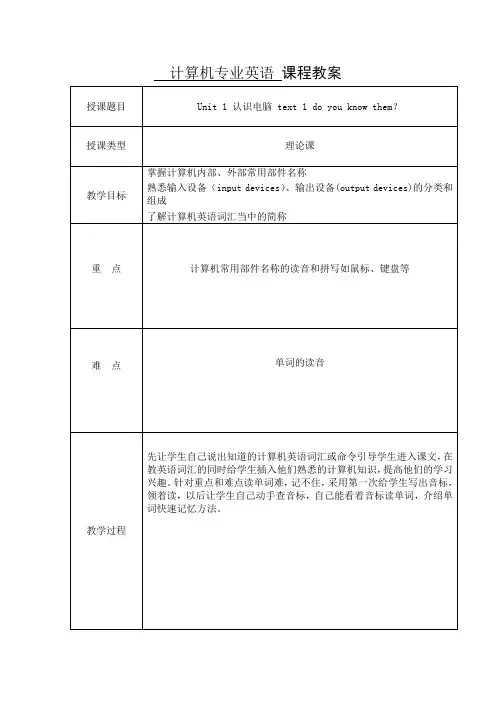
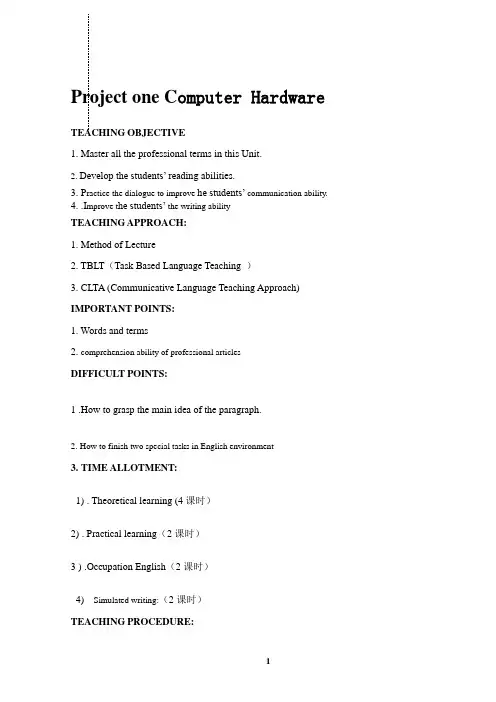
Project one C omputer Hardware TEACHING OBJECTIVE1. Master all the professional terms in this Unit.2. Develop the students’ reading abilities.3. P ractice the dialogue to improve he students’ communication ability.4. .I mprove t he students’ the writing abilityTEACHING APPROACH:1. Method of Lecture2. TBLT(Task Based Language Teaching )3. CLTA (Communicative Language Teaching Approach) IMPORTANT POINTS:1. Words and terms2. comprehension ability of professional articlesDIFFICULT POINTS:1 .How to grasp the main idea of the paragraph.2.How to finish two special tasks in English environment3.TIME ALLOTMENT:1) . Theoretical learning (4课时)2) . Practical learning(2课时)3 ) .Occupation English(2课时)4) Simulated writing:(2课时)TEACHING PROCEDURE:I. Part A Theoretical learningTraining Target:In this part, our target is to improve the speed of reading professional articles and the comprehension ability of the reader. We have marked key words in some paragraphs so the reader can grasp the main idea of the paragraph.Reading:Computer Hardware1. Background of informationPPT (Omitted )2、Questions before readingWhich five basic parts does the computer include?What is the main function of the motherboard?How about the developing trend of removable storage devices in the future?3、NotesALU (A rithmetical and L ogical U nit),算术逻辑运算单元。
计算机专业英语全套教案第一课:计算机基础词汇教学目标:1. 学生能够掌握计算机专业的基本英语词汇。
2. 学生能够运用这些词汇进行简单的英语交流。
教学内容:1. 计算机硬件词汇:CPU, RAM, HDD, SSD, Motherboard, Graphics Card, etc.2. 计算机软件词汇:Operating System, Application Software, Utility Software, etc.3. 计算机网络词汇:Internet, Network, Router, Switch, IP Address, etc.教学步骤:1. 导入:通过展示计算机硬件和软件的图片,引导学生猜测其英文名称。
2. 新课内容讲解:详细讲解每个词汇的含义、用法,并给出示例句子。
3. 练习:分组进行角色扮演,运用所学词汇进行对话练习。
作业:1. 抄写本节课所学词汇,并用每个词汇造一个句子。
2. 搜集计算机专业英语词汇,扩充自己的词汇库。
第二课:计算机编程英语教学目标:1. 学生能够理解计算机编程的基本英语术语。
2. 学生能够阅读简单的计算机编程英文资料。
教学内容:1. 编程基础词汇:Variable, Function, Loop, Condition, Array, etc.2. 编程语言名称:C++, Java, Python, JavaScript, etc.3. 编程语句:If, Else, While, For, Switch, etc.教学步骤:1. 导入:简要介绍计算机编程的重要性,引发学生学习兴趣。
2. 新课内容讲解:讲解编程英语词汇和语句,结合实际编程案例进行分析。
3. 练习:分组讨论,用英语描述一个简单的编程问题及解决方案。
作业:1. 抄写本节课所学编程英语词汇,并用每个词汇造一个句子。
第三课:计算机网络英语教学目标:1. 学生能够理解计算机网络的基本概念和英语表达。
2. 学生能够描述计算机网络的结构和功能。
计算机专业英语教案第一章:计算机科学简介1.1 教学目标了解计算机科学的基本概念和发展历程。
掌握计算机科学领域的关键技术。
能够阅读和理解计算机科学相关的英文文献。
1.2 教学内容计算机科学的定义和发展历程。
计算机科学领域的关键技术,如算法、数据结构、编程语言、软件工程、等。
计算机科学领域的著名人物和他们的贡献。
1.3 教学方法采用讲授法介绍计算机科学的基本概念和发展历程。
通过案例分析法讲解计算机科学领域的关键技术。
引导学生阅读和理解计算机科学相关的英文文献。
1.4 教学资源教材:《计算机科学概论》辅助材料:相关领域的英文文献、案例分析等。
1.5 教学评价课堂参与度:提问、讨论等。
课程报告:分析一个计算机科学领域的关键技术。
第二章:编程语言基础2.1 教学目标了解编程语言的基本概念和分类。
掌握常见编程语言的基本语法和特性。
能够阅读和理解编程语言相关的英文文献。
2.2 教学内容编程语言的定义和分类。
常见编程语言的基本语法和特性,如Python、Java、C++等。
编程语言的发展趋势和新技术。
2.3 教学方法采用讲授法介绍编程语言的基本概念和分类。
通过编程实践法讲解常见编程语言的基本语法和特性。
引导学生阅读和理解编程语言相关的英文文献。
2.4 教学资源教材:《编程语言基础》辅助材料:相关领域的英文文献、编程实践案例等。
2.5 教学评价课堂参与度:提问、讨论等。
编程实践:编写简单的程序,展示对编程语言的理解。
第三章:数据结构与算法3.1 教学目标了解数据结构的基本概念和常见类型。
掌握常见算法的原理和实现。
能够阅读和理解数据结构与算法相关的英文文献。
3.2 教学内容数据结构的基本概念和常见类型,如数组、链表、栈、队列、树、图等。
常见算法的原理和实现,如排序算法、查找算法、动态规划等。
算法分析的基本概念和方法。
3.3 教学方法采用讲授法介绍数据结构的基本概念和常见类型。
通过算法实现和分析讲解常见算法的原理和实现。
.教案首页(第11次课,2学时)授课题目Unit 9 Data Transimission Media教学目的通过讲授,使学生了解各种传输媒介的英文描述与要求教学重点传输媒介的专业术语教学难点课文的理解、翻译教学内容:单词、课文教学过程教学方法:讲授法课后作业P128-133,1-5教学后记Unit 9 Data Transimission Media一、传输媒介支持数据传输的传输媒介有:电话线、同轴电缆、微波信号、卫星系统和光纤。
电话线即为双绞线,它由四对线组成,其中每对由两条带绝缘层的导线以螺旋形式绞合在一起。
传输距离小,抗干扰能力弱、但价格便宜。
同轴电缆:由内外两个导体构成,内导体是一根铜质导线,外导体是铜箔构成,起屏蔽干扰作用。
传输距离适中、抗干扰能力强。
光纤:光缆纤缆作为信号传输介质,把电信号转换成光信号,进行传输。
传输距离远、抗干扰能力强、传输信号量大且信号不失真,但价格贵。
二、New Words1.amplifier n.放大器,扩音机2. antenna n.触角,触须;天线3. boost vt.提高;推动;宣扬n.增涨;推动,激励Boost an electric current增强电流Give sb’s confidence a boost增强某人的信心4. channel n.频道;信道;沟渠;海峡,航道Your favourite channel你最喜欢的频道5. circuit n.电路,线路;环行,环行道The circuit of the city is three miles.环城线路有三英里。
6. coaxial同轴的; 共轴; 共轴的7. compensate v.补偿,弥补,抵消She was compensated by the insurance company for her injuries.她受伤后获得保险公司的赔偿。
8. curvature弧度,曲率,弯曲The curvature of the earth ‘s surface.地球表面的曲度。